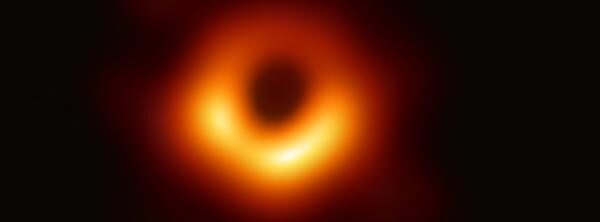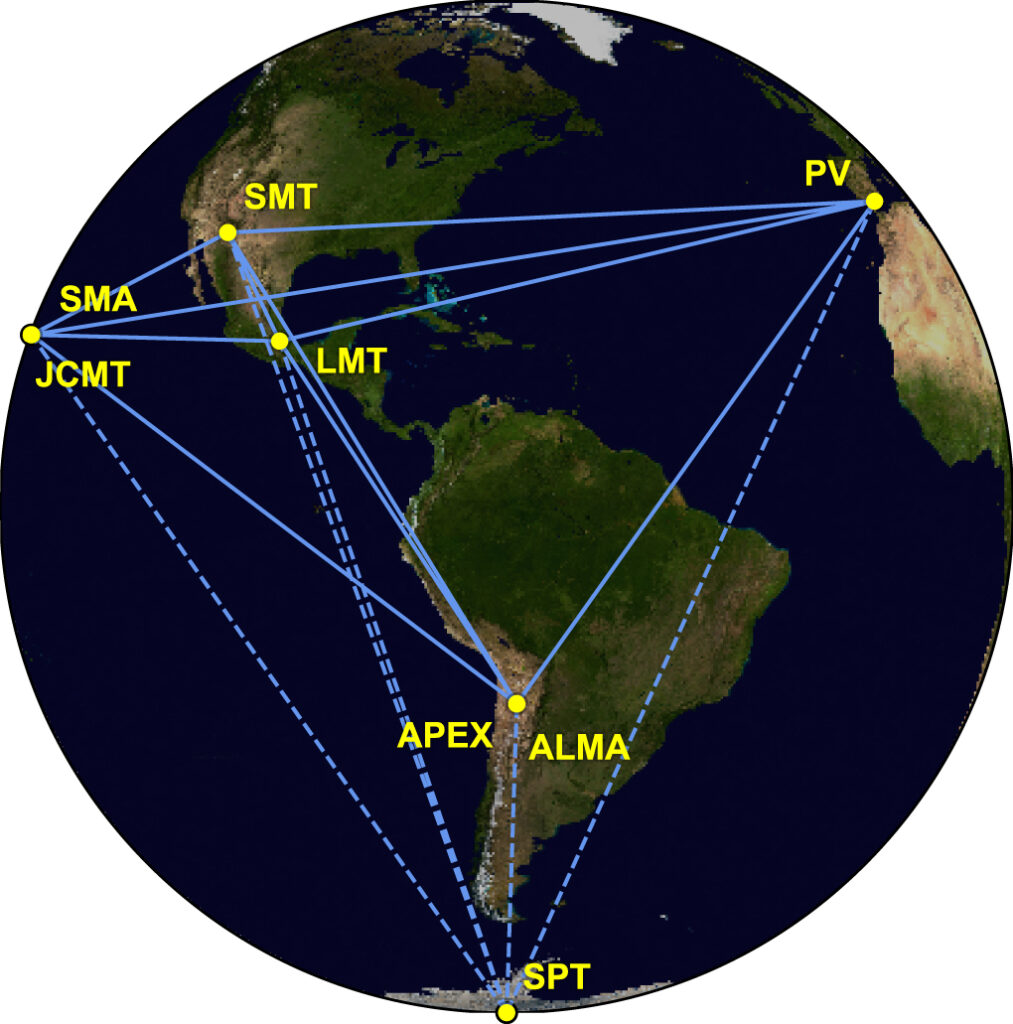
Event Horizon Telescope
The Event Horizon Telescope (EHT) Collaboration is a group of observatories united to image the emission around supermassive black holes.
In 2019, the EHT produced iconic images of the emission around the black hole in M87. The images showed a ring, as predicted by general relativity. The size of the ring indicates that the black hole has a mass that is 6.5 billion times that of the Sun. The images provide evidence that the structure of the emission in M87 changed over the course of six days of observing.

Another prime target of the EHT is Sagittarius A* (Sgr A*), the black hole in the center of the Milky Way. Estimates of the mass of the black hole in Sgr A* are much smaller than for M87, weighing in at only 4 million times that of the Sun. Due to this much lower mass, the timescale of variability in Sgr A* is mere minutes, making imaging much more challenging.
The EHT Array
The EHT observes at a frequency of 230 GHz (a wavelength of 1.3 mm) using the technique of very long baseline interferometry (VLBI). With VLBI, observatories across the planet act as an Earth-sized telescope, able to resolve features with an angular size of less than 20 microarcseconds, equivalent to being able to view an orange on the surface of the moon.
The EHT array consists of telescopes in France, Spain, Greenland, Chile, the United States (Arizona and Hawaii), Mexico, and the South Pole. These telescopes simultaneously observe a target source, recording petabytes of data onto hard drives that are later shipped back to MIT Haystack Observatory and the Max-Planck-Institut für Radioastronomie in Bonn, Germany. The data are run through the Haystack correlator, producing a smaller dataset that can be calibrated and imaged.
Haystack Director Colin Lonsdale answered common questions about black holes and the historic image of M87 (with EHT scientist Katie Bouman) for the National Science Foundation (NSF):
Instrumentation
Single-dish EHT observatories capture data using a block downconverter (BDC), a ROACH2 digital backend (R2DBE), and Mark 6 data recorders. The Haystack-designed BDC converts signals down to the frequency range sampled by the R2DBE. Haystack also designed the Mark 6 systems that record the R2DBE output and play data back at the correlator.
A key development enabling the EHT to produce high-impact scientific results is the ALMA Phasing Project, a Haystack-led project to sum the signals from individual antennas in the ALMA array in Chile into a very sensitive element of the array. The spectacular performance of phased ALMA provides robust detections to other telescopes in the EHT, making it much easier to detect sources on long baselines and calibrate the data.

Algorithms
The main EHT data reduction pathway uses the Haystack Observatory Post-processing System (HOPS). Originally designed in the 1990s to handle geodetic VLBI data, HOPS has proven to be well suited to the challenges of reducing millimeter VLBI data. Haystack is in the middle of a development program to modernize HOPS based on lessons learned from years of handling EHT data.
Haystack is at the forefront in algorithms to turn calibrated data into images. The Sparse Modeling Imaging Library for Interferometry (SMILI) has proven to be better than traditional imaging methods at reconstructing super-resolved images.
Goals
The EHT aims to image the region affected by strong gravitational lensing around supermassive black holes. General relativity predicts that a bright photon ring will appear whose size is proportional to the mass of the black hole. Confirming that the inner edge of the ring is circular and of the predicted size constitutes a test of general relativity in a strong-field environment. M87 and Sgr A* are the primary targets in which the photon ring is easily resolvable by the EHT.
The EHT also aims to understand the astrophysics of supermassive black hole systems. The two main targets for general relativity, M87 and Sgr A*, are very different in astrophysical character. M87 is a low-luminosity active galactic nucleus (AGN) source that launches a jet that is prominent at radio and optical wavelengths. Sgr A* has no obvious jet and is orders of magnitude smaller than M87 in mass and accretion rate. In addition to these two sources, the EHT observes a wide range of AGN sources with prominent jets, ranging from radio galaxies to blazars, at a resolution unobtainable with any other instrument.
Future Directions
The EHT is pushing toward observing at 345 GHz (0.87 mm), which will enable imaging at even higher angular resolution. The EHT is also laying the groundwork for extended observing campaigns to make movies of jet launching in M87.
Project Team

- Kazunori Akiyama
- John Barrett
- Roger Cappallo
- Geoff Crew
- Joseph Crowley
- Mark Derome
- Kevin Dudevoir
- Vincent Fish
- Michael Hecht
- Colin J. Lonsdale
- Lynn Matthews
- Kotaro Moriyama
- Michael Poirier
- Alan E.E. Rogers
- Chester Ruszczyk
- Jason SooHoo
- Don Sousa
- Michael Titus
- Alan Whitney